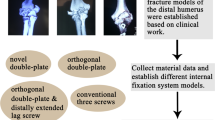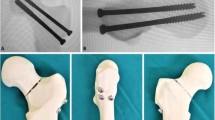Abstract
Objectives
To measure quantitatively the strains in the concave and convex sides of a femur to substantiate the Arbeitsgemeinschaft für Osteosynthesefragen (AO) tension band principle.
Methods
Eight cadaveric fresh-frozen femurs were cleaned of soft tissue and prepared for mounting the strain gages (Vishay, Raleigh, NC). The student strain gages were mounted at the anterior, lateral and medial surfaces of a femur. They were loaded at 100, 250, 500, 1,000 and 1,500 N axial forces in a mechanical testing machine (Instron Model 4202, Norwood, MA) and the micro strains were measured for intact and after fixation of a simulated fracture by an eight hole broad 4.5 mm stainless steel compression plate (Synthes LCP). In order to simulate the fracture conditions, where all eight screw holes might not be filled, three different arrangements were tested: 8 screws, 4 screws and 2 screws. The microstrains under different loads were analyzed by Analysis of Variance (ANOVA) with Holm-Sidak multiple comparison method.
Results
At the same gage location micro strains were not significantly different between the intact, and the femur fixated by 8, 4 and 2 screws. For intact bones at 1,500 N the strain ratio between the tension to compression sides was −0.21 proximally and −0.04 distally. The comparison of these strain ratios at different loads did not show any significant differences at p = 0.05 and power of 0.8.
Conclusions
The data showed a trend validating the tension band principle as tensile strains lowered and compressive strains increased after placement of the plate.



Similar content being viewed by others
References
Koch JC (1917) The laws of bone architecture. Am J Anat 21:177–292
Fetto J, Leali A, Moroz A (2002) Evolution of the Koch model of the biomechanics of the hip: clinical perspective. J Orthop Sci 7:724–730
Pauwels F (1980) Biomechanics of the locomotor apparatus. Springer, New York, pp 430–449
Josten C, Muhr G (2000) Tension band principle. In: Ruedi TP, Murphy WM (eds) AO principles of fracture management. Thieme, New York, pp 187–192
Hutchinson DT, Horwitz DS, Ha G et al (2003) Cyclic loading of olecranon fracture fixation constructs. J Bone Joint Surg Am 85:831–837
Parkinson DE, Joseph R, Edelman R (1988) Biomechanical principles of tension band wiring applied to fractures of the distal fibula and fifth metatarsal base. J Foot Surg 27:149–156
Volpon JB, Batista LC, Shimano MM, Moro CA (2008) Tension band wire fixation for valgus osteotomies of the proximal femur: a biomechanical study of three configurations of fixation. Clin Biomech 23:395–401
Birnbaum Klaus, Prescher Andreas, Niethard Fritz-Uwe (2010) Hip Centralizing forces of the iliotibial tract within various femoral neck angles. J of Pediatric Orthopaedics B 19(2):140–149
Tichy P, Tillman B (1989) The tension band effect of the iliotibial tract. Unfallchirurg 92(5):240–244
Merican AM, Ami AA (2009) Iliotibial band tension affects patellofemoral and tibiofemoral kinematics. J Biomech 42:1539–1546
Farrell KC, Reisinger KD, Mark D (2003) Tilma. Force and repetition in cycling : possible implications for iliotibial band friction syndrome. Knee 10:103–109
Cordey J, Boregaud M, Frankle M, Harder Y, Martinet G (1999) Loading model for the human femur taking the tension band effect of the ilio-tibial tract into account. Injury Int J Care Injured 30:SA26–SA30
Acknowledgment
The authors wish to thank Synthes (Paoli, PA) for supplying the plates and screws for the study. No financial help was received.
Author information
Authors and Affiliations
Corresponding author
Rights and permissions
About this article
Cite this article
Hommel, G.J., Lobrano, C., Ogden, A.L. et al. A quantitative analysis of tension band plating of the femur diaphysis. Arch Orthop Trauma Surg 131, 1325–1330 (2011). https://doi.org/10.1007/s00402-011-1294-5
Received:
Published:
Issue Date:
DOI: https://doi.org/10.1007/s00402-011-1294-5




